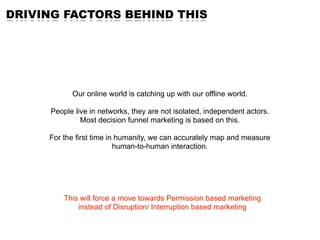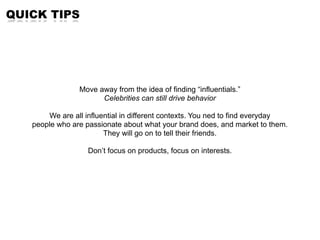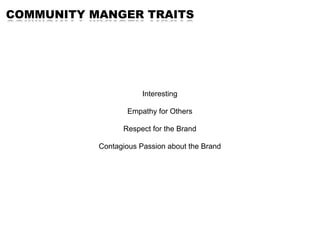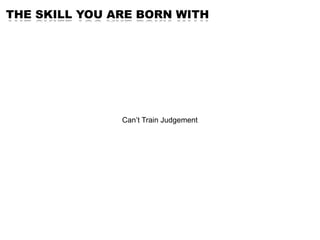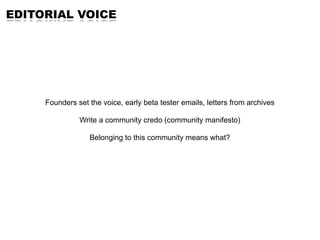SXSW Learnings
- 1. SXSW LEARNINGS Griffin Farley 2012
- 2. PHASES OF THE WEB
- 3. THE FIRST PHASE OF THE WEB Documents linked together. For brands this often meant copying and pasting their print marketing materials online. When we interacted with websites, we couldn’t interact with other people.
- 4. THE SECOND PHASE OF THE WEB With the second phase we started seeing opportunities for interaction with others. Some websites had reviews, and ways to leave comments. Many brands added social network buttons to their existing site pages. This social behavior was bolted on.
- 5. THE THIRD PHASE OF THE WEB We are now in the third phase of the internet where websites are being rebuilt around people. Social behavior is the key feature. It is not bolted on.
- 6. QUICK TIPS Don’t think about the social web as a set of features to add on to your existing site. The social web is not about adding a “like” button or a “share” button. Zynga, Facebook Photos and Etsy reinvented businesses by designing around people. Think of the social web like you think of electricity. It’s always there powering everything else. Social behavior is the same: always there, motivating us to act.
- 7. A CASE AGAINST THE TIPPING POINT
- 8. THE LAW OF THE FEW If you reach and influence the minority of influential people in society, they will in turn influence hundreds, thousands and even millions of others. Much marketing in the last ten years has been focused on finding and seeding messages with these “influentials.”
- 9. HOW WE WANT MARKETING TO WORK This focus on “influentials” is mostly based on a view of how we want the world to work versus how it actually works. 15% 85% of influencers of non-influencers 30% 70% of conversations of conversations Focus marketing efforts on lots of small connected groups vs. a few influencers
- 10. DRIVING FACTORS BEHIND THIS Our online world is catching up with our offline world. People live in networks, they are not isolated, independent actors. Most decision funnel marketing is based on this. For the first time in humanity, we can accurately map and measure human-to-human interaction. This will force a move towards Permission based marketing instead of Disruption/ Interruption based marketing
- 11. QUICK TIPS Move away from the idea of finding “influentials.” Celebrities can still drive behavior We are all influential in different contexts. You ned to find everyday people who are passionate about what your brand does, and market to them. They will go on to tell their friends. Don’t focus on products, focus on interests.
- 14. COMMUNITY MANGER TRAITS Interesting Empathy for Others Respect for the Brand Contagious Passion about the Brand
- 15. THE SKILL YOU ARE BORN WITH Can’t Train Judgement
- 16. HIRING A COMMUNITY MANAGER Disregard Resumes, Odd Backgrounds, Hire Interesting People Their Attitude: Here I am and this is how I can add value They need to be a reflection of their audience They need to be an employee first, fan second Nobody had success converting a fan into a community manager
- 17. EDITORIAL VOICE Founders set the voice, early beta tester emails, letters from archives Write a community credo (community manifesto) Belonging to this community means what?
- 18. QUICK TIPS User of the Day Real Life Events for Users to Attend
- 20. ROCK STARS OF THE BUSINESS WORLD
- 21. THE NUMBER A year ago their were less than 10 start up accelerators Now their are more than 200 Next year their could be 1000
- 22. THE DEALS If they accept you you get $6,000 per founder, max $18,000 Have to work out of the accelerator for 3 months They get your product to the next phase (whatever that is) They put you in front of Venter Capitalists and Angel Investors
- 23. QUICK TIPS If you have an idea find a start-up accelerator that has done the following: A history of funding A network of mentors An in-house team that can get your idea to the next phase An accelerator that doesn’t take more than 6% equity










